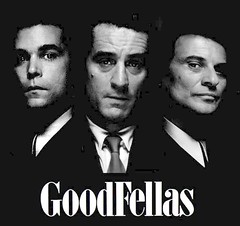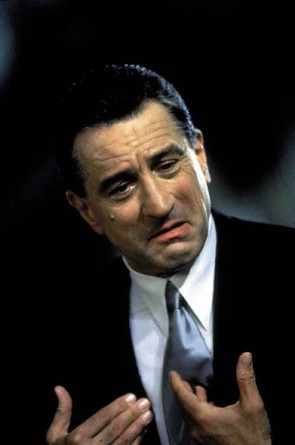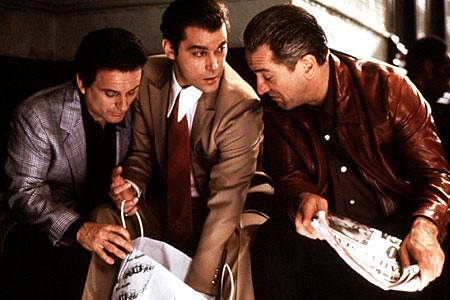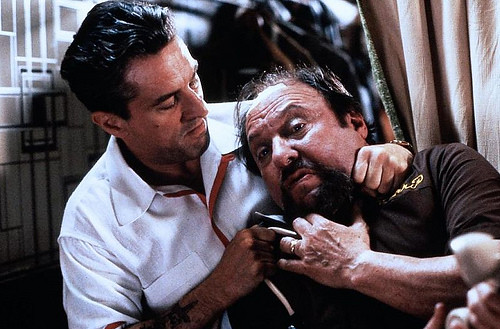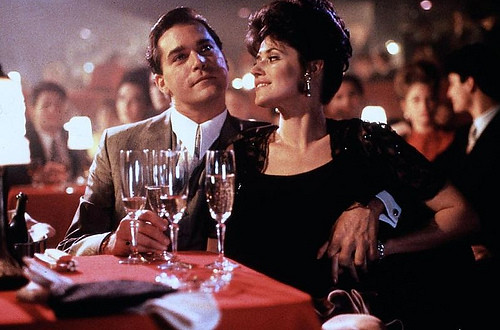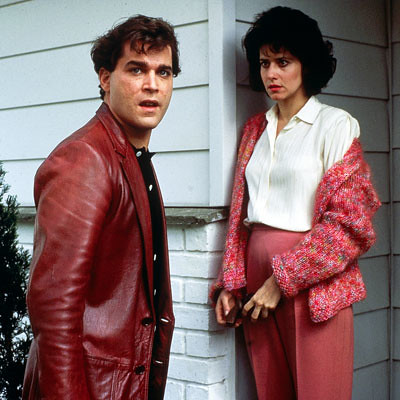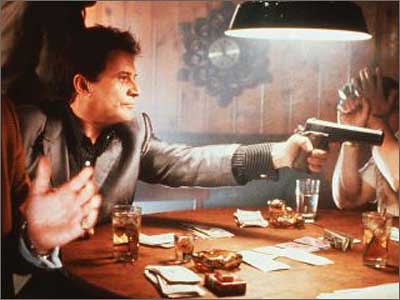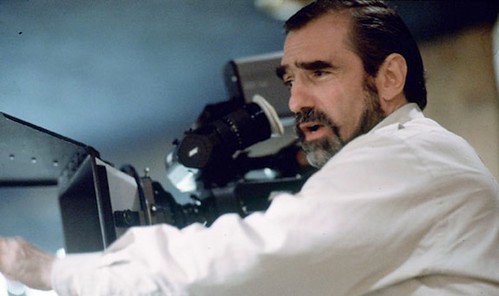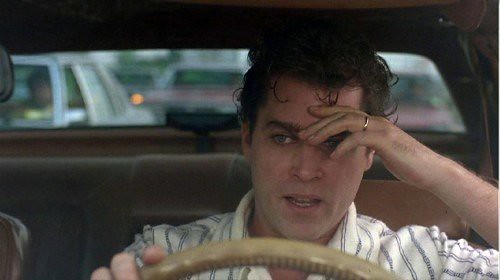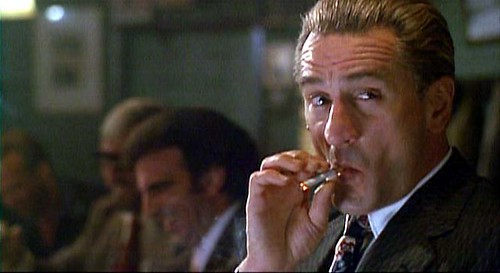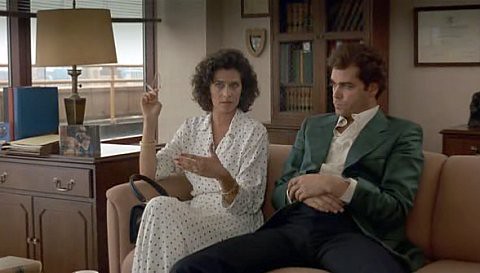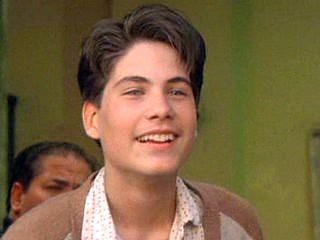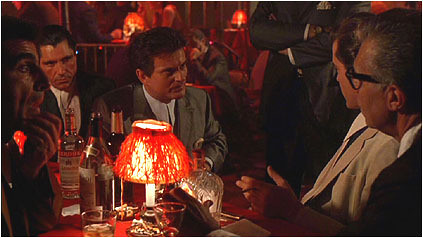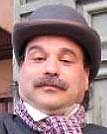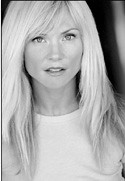GOODFELLAS
Your November Unrandom Movie Club Results Are In!
Tagline: Murderers come with smiles. (Really? That's the tagline???)
Pizza: Guido's Pizza
Preshow Entertainment: None
Thinkabouddit! What has Bobby done in the past two decades that comes close to being hailed as blow-you-out-of-the-water amazing? Let me help you; RIGHTEOUS KILL? GODSEND? SHOWTIME? 15 MINUTES? MEN OF HONOR? THE FAN? Or perhaps it was THE ADVENTURES OF ROCKY AND BULLWINKLE? Oh wait, wasn't it when he played The Creature in Kenneth Branaugh's version of FRANKENSTEIN? Okay, sure, De Niro's been good in some movies like RONIN, THIS BOY'S LIFE and CASINO (a/k/a GOODFELLAS-lite), but has he ever really packed a Jake La Motta punch since 1990? I suppose you can argue that his turn as Max Cady in the CAPE FEAR remake was decent...and if you look at me the right way, maybe I'll agree it was only a little cartoony. As for his comedy performances; all that ANALYZE THIS, THAT and the other FOCKER things seem too Robert De Zero. I'll go out on a limb to say that if another actor had made these same movies, no one would bat a skull. We're brainwashed to think De Niro = Greatness, and I'm here to tell you in my sweet yet condescending way - wake the hell up. So come on, say it along with me, out loud, with your blinders on the nightstand - De Niro isn't a gunslinger anymore.
The same applies to Marty. If we gloss over crap like BRINGING OUT THE DEAD, we're left with B.O. hits like THE AVIATOR, THE DEPARTED, GANGS OF NEW YORK and SHUTTER ISLAND. Sure, people flocked to them and loved them. But me? I found them little more than overblown pomp. It seems Scorsese likes to make movies in the style and substance that he grew up with in the 1950s and give them his stamp. There's certainly nothing wrong with that if you're offering up something exciting. But I meant what I said. GOODFELLAS (1990) is the last thing either of them did that knocked me out.
But wow did it knock me out, to the point where it may actually be my favorite Scorsese movie. Say, have enough years gone by that we can call GOODFELLAS a classic movie? It's everything you want; violent, funny, serious, smart and suspenseful. And what great characters; everyone from De Niro's menacing Jimmy Conway to Joe Pesci's out of control Tommy DeVito to Ray Liotta's unforgettable Henry Hill to bit players like Jimmy Two Times ("I'm gonna get the papers, get the papers."). But this movie is not just a brutal and honest portrait of colorful characters trapped (for better and ultimately for worse) in a lifestyle, it's also a dizzy and dazzling display of filmmaking. GOODFELLAS kills, or perhaps I should have said - whacks.
Based on the Nicholas Pileggi book (which I actually read) WISEGUY (they changed the title so it wouldn't be confused with the TV show WISEGUY...a terrific show that arguably launched Kevin Spacey's career), GOODFELLAS is the true story of gangster Henry Hill. It's a biopic with vignettes strung together (not always chronologically) tracking the years 1955-1980, and the rise and fall of a guy who "as far back as I can remember" wanted to be a gangster. The movie is so much of a character study that even though the real players pulled off the biggest cash getaway in U.S history at the time (the Lufthansa heist), we never get to see a single frame of it on screen...just the set-up and the aftermath. What other movie can get away with that?
With all its violence and brazen criminal activity, the underpinning of the film is the seduction of the gangster lifestyle - "For us, to live any other way was nuts. To us, those goody-good people who worked shitty jobs for bum paychecks, who took the subway to work every day and worried about their bills, were dead. They were suckers." I mean, who wouldn't want that? Of course, it comes with a monkey's paw: the real Henry Hill is on the DVD's extras, and he tells us that he is "thankful to still be alive," largely due to everyone who would want him dead being incarcerated (thanks to him) or dead themselves. "I lived in fear constantly at that time...and you couldn't show it because that was a sign of weakness." Suddenly our bum paychecks don't seem so suckery anymore.
Hill was born half Irish, so he could never be a made man, but he came as close as he could. As a tween, he parked Caddies for the wiseguys, and soon graduated into burning down the competing cab stand. Then came black market cigarettes, Kennedy (at that time called Idlewild) Airport robberies, truck hijackings, beatings, murders (funny how Hill doesn't seem to implicate himself in these as much as he does others), the aforementioned magnitudinous Lufthansa heist, and finally, his drug commerce and addiction. And with him through it all are fellow Irish gangster and feared guy Jimmy Conway and crazy/dangerous sociopath Tommy DeVito, an underling to capo Paul Cicero (Paul Sorvino). Although Henry, Jimmy and Tommy were often a rogue team, they saw to it that Paulie would get a cut.
On the non-criminal side, Hill marries Karen (Lorraine Bracco), yet like all goodfellas, also has a girlfriend, Janice (the late Gina Mastrogiacomo, who I think may have been Italian). At the Copacabana, Saturdays were for the wives, Fridays were for the girlfriends. Ya know, now that I'm thinking about it, maybe fearing for your life every single day is worth the trade-off.
GOODFELLAS is fueled by its voiceover, which some people find fault with. Me? I can't get enough of it. Henry is telling the story to us...to me. Actually, Liotta got a sound guy who happened to be in the studio, sat him in a chair, and did the VOs to him. But still, it becomes personal. The writing and performance of the VOs are gold class. But about 40 minutes into the film, a funny thing happens; that VO switches from Henry's to Karen's. It's an odd yet effective thing to do (Marty), for now we are invested in two people's lives. We understand him and we understand her, and we see how it all happened. And our dark sides root for them.
There is a blood-spattered laundry list of violent scenes, each one memorable and...real, mostly due to the natural and largely ad libbed dialogue they did in rehearsals that were, for the most part, locked-in by the time they were shooting. The most real scene in the movie for me is when Henry goes after Karen's neighbor Bruce. It's brutal and raw and so believable that I actually think the actor bled (though I'm sure he didn't). But it's what happens moments later that is important. This incident cements Karen's excitement regarding the wiseguy lifestyle.
So much of the movie has no real story on the outside. It's Henry's seduction, then Karen's. And once they're in, we get a few pivotal, game-changing moments. One is when Tommy kills someone for practically no reason at all, and we see that look on Henry's face (for the first time, he's got our look of disbelief). The rules are different now. All bets are off. Loose cannon Tommy is emblematic of the volatile lifestyle, and if Henry didn't know it up to this point, he sure does now. And so do we.
The last fifth of the 2 hr 25 min. picture deals with the effect drugs have on Henry, both selling them and using them. And once again, the movie changes, though this time it's in the filmmaking rather than the story. To match Henry's hyper paranoia, GOODFELLAS becomes more frenetic, with quick cuts (some of them jump cuts), and faster scenes. Towards the end, besides that damned helicopter that seems to be following him, all Henry cares about is smuggling the coke and stirring the spaghetti sauce.
GOODFELLAS is like a racehorse. It gallops out of the gate (that first scene is disgustingly delicious) and keeps moving until it's over. And the jockey here is Martin Charles Scorsese, who, how can I put this - knew what he was doing. Every shot, every word, every piece of music (more on that in a moment), every detail right down to the color of someone's tie. Aside from his own talents, Scorsese (pronounced scor SEH zee if you know him or are pretentious) effectively incorporates French New Wave rule-breaking attitudes that give GOODFELLAS a flavor not often tasted in America, but would soon be copied en masse. Of course there's the legendary Copa Shot which everyone goes gaga for (just YouTube "Copa Goodfellas"), but let's dig deeper. Scorsese himself has cited the Truffaut-influenced JULES AND JIM-y opening sequence and frame freezing. One particular powerful freeze frame comes when young Henry sets fire to the cab stand. He runs towards the camera and as the cars explode behind him, the freeze catches Henry mid-run, arms outstretched, reminiscent of the famous Vietnam still. Scorsese also employs Fellini's pre-Wave I VITELLONI to intro the wiseguys (if you've seen these films, you'll know he's right). Also, let's applaud the camera work. Whether it was drawing on or extinguishing a cigarette, snorting coke, or simply tightening their eyes, Scorsese's use of accelerated push-ins on faces is thrilling.
Then there's the little touches, like the Steadicam shot revealing two dead people in a car. The camera keeps moving to show the price sticker still glued to the passenger side window...smeared in blood. Another shot has Henry walking off the courtroom stand and talking to us, as if putting a visual button on his VO.
Scorsese sure has his own way with music. Often, he'd play the actual songs right there on the set as they filmed the scenes. Other times, he'd scribble the song choices in his script. And I don't know how he does it, but the songs always seem to fit perfectly into the scene, almost as if they were written expressly for the shots. I'm reminded of just how important A WHITER SHADE OF PALE was to Scorsese's LIFELESSONS segment in NEW YORK STORIES, made a year earlier, and how it seemed to me that no other song could work there. From old school Italian songs through LAYLA, Scorsese timelines the movie using no anachronistic music. (SIDENOTE: GOODFELLAS is the second film at RMC this year featuring Dino singing AIN'T THAT A KICK IN THE HEAD...OCEAN'S 11 being the first).
Also under the Scorsese umbrella? Casting! Liotta's performance is often overshadowed by heavier-hitter De Niro's and scene-stealer Pesci's, but I have to say, it's Liotta that carries the whole movie on his back. His Caesar-Romero-as-The-Joker laugh would make you smile if it weren't putting a chill down your spine. He used it when his mother-in-law yelled at him for coming home at dawn, and he used it when Tommy smashes a bottle over a restaurant owner's head. That laugh meant that this man, and the men around him, can do whatever they want and not only get away with it, but laugh at it. Oh, that Liotta Laugh. It's the worst kind of evil - it's cavalier evil.
And De Niro. When he gets into a bad guy character's skin, he's unbeatable. It's always his bad guys that make him shine for me. FALLING IN LOVE, STANLEY AND IRIS. Feh and meh. Gimme Vito Corleone and Jimmy Conway (it helps that this sounds like Jimmy Cagney).
Lorraine Bracco's also pretty amazing as the conflicted Karen, who ended up getting turned on by the danger of it all. In a way, her arc changed more than the others, who were either born into gangsterdom or fell into it as a kid. She went from innocent Jewess to mobster wife, showing a range including love, betrayal and an internal moral conflict. I love the scene where she's defending Henry to her mother in a screaming match. As she leaves the room disgusted, she shouts out, "Da-a-ad!," as if daddy, who never says anything, will side with her. It was such a small moment (does Lorraine even remember it?), yet so honest.
In a subdued yet menacing performance is Paul Sorvino, who regretted being in GOODFELLAS after watching the first screening. He's had a change of heart since, saying he was "so blown away by the movie I was in a state of shock."
These were early roles for Bracco, fellow Soprano alum Michael Imperioli (in the small yet critical part of Spider), Debi Mazar, and even Ray Liotta, who really only had one high profile movie (SOMETHING WILD, the movie where Scorsese noticed him) behind him.
There are also a batch of characters with names that sound like they're in SEUSSFELLAS - Johnny Roastbeef, Joe Buddha, Billy Batts, Frenchie, Freddy No Nose, Pete the Killer and Frankie the Wop. Okay, maybe those last two would be a little edgy for Seuss. But what I'd really like to know is what the hell happened to Christopher Serrone, the kid who played young Henry? Man, he was just so good. You totally believe he grows up to be Ray Liotta. But GOODFELLAS is his only movie. Yet another crime he's committed. But wait! He's got a part in a movie that...was supposed to come out in January 2011? Uccch.
If you've seen GOODFELLAS, then you're well aware of the notorious "How am I funny?" scene. Though widely thought to be an improvised scene, it was actually born out of improvisation stemming from a real incident that once happened to Pesci. By the time they were ready to shoot, the scene was pretty solid. I know this because I was on the set that day. Well, no, I wasn't there, but Ray Liotta told me. Okay, he didn't really tell me, but I did read it in a magazine. But whatever, that scene is just one of the many that give you a feeling of utter dread, because every time someone opens their mouth or looks at you funny or smiles at you reassuringly, you feel like something very bad is about to happen. And sometimes it does, and sometimes it doesn't. It's an intellectual cat-scare.
At the end of his commentary, Hill cautions us that "some of the scenes in the movie may look good but I tell ya, you don't want to live that kinda life." And he's right. Why would you want to look behind you everywhere you go? And wonder if you're going to be whacked by your enemy, or worse, your friend? Because, as Hill/Liotta tells us at the end of the movie when he's in the Witness Protection Program: "I'm an average nobody. I get to live the rest of my life like a schnook." Welcome to my world, Henry.
Man, it's just so weird listening to that commentary, where he tells stories about the actual crimes which include murders, and says things like, "When we opened the trunk, Billy just looked at me....begging...it was horrible...he knew he was dead." And by his side on the track, Edward McDonald, the Fed who actually placed Henry and Karen in the Witness Protection Program (and played himself in the film). There they are, sitting next to each other (I assume) going over Henry's crimes as they unfold (another extra has a brief visual moment of Hill and Liotta sitting side by side). But yeah, okay, if it weren't for Hill's rat-laden testimony, they wouldn't have snagged so many big fish (hey, doesn't pesci mean fish?). And let me tell you something, Hill still talks like a goodfella: "We was able to get away with so much shit." Hill's since been kicked out of the WPP, battled drugs and alcoholism, visited rehab more than once, worked as a chef at his restaurant, and currently sells his GOODFELLAS-related artwork and other items on eBay. So now that the gun smoke has cleared, he's just trying to make a living. You know, like the rest of us schnooks.
Tagline: Murderers come with smiles. (Really? That's the tagline???)
Pizza: Guido's Pizza
Preshow Entertainment: None
IF YOU ASK ME,
GOODFELLAS WAS THE LAST TIME DE NIRO AND SCORSESE MADE AN EXCEPTIONAL MOVIE... ALONE OR TOGETHER.
GOODFELLAS WAS THE LAST TIME DE NIRO AND SCORSESE MADE AN EXCEPTIONAL MOVIE... ALONE OR TOGETHER.
Thinkabouddit! What has Bobby done in the past two decades that comes close to being hailed as blow-you-out-of-the-water amazing? Let me help you; RIGHTEOUS KILL? GODSEND? SHOWTIME? 15 MINUTES? MEN OF HONOR? THE FAN? Or perhaps it was THE ADVENTURES OF ROCKY AND BULLWINKLE? Oh wait, wasn't it when he played The Creature in Kenneth Branaugh's version of FRANKENSTEIN? Okay, sure, De Niro's been good in some movies like RONIN, THIS BOY'S LIFE and CASINO (a/k/a GOODFELLAS-lite), but has he ever really packed a Jake La Motta punch since 1990? I suppose you can argue that his turn as Max Cady in the CAPE FEAR remake was decent...and if you look at me the right way, maybe I'll agree it was only a little cartoony. As for his comedy performances; all that ANALYZE THIS, THAT and the other FOCKER things seem too Robert De Zero. I'll go out on a limb to say that if another actor had made these same movies, no one would bat a skull. We're brainwashed to think De Niro = Greatness, and I'm here to tell you in my sweet yet condescending way - wake the hell up. So come on, say it along with me, out loud, with your blinders on the nightstand - De Niro isn't a gunslinger anymore.
The same applies to Marty. If we gloss over crap like BRINGING OUT THE DEAD, we're left with B.O. hits like THE AVIATOR, THE DEPARTED, GANGS OF NEW YORK and SHUTTER ISLAND. Sure, people flocked to them and loved them. But me? I found them little more than overblown pomp. It seems Scorsese likes to make movies in the style and substance that he grew up with in the 1950s and give them his stamp. There's certainly nothing wrong with that if you're offering up something exciting. But I meant what I said. GOODFELLAS (1990) is the last thing either of them did that knocked me out.
But wow did it knock me out, to the point where it may actually be my favorite Scorsese movie. Say, have enough years gone by that we can call GOODFELLAS a classic movie? It's everything you want; violent, funny, serious, smart and suspenseful. And what great characters; everyone from De Niro's menacing Jimmy Conway to Joe Pesci's out of control Tommy DeVito to Ray Liotta's unforgettable Henry Hill to bit players like Jimmy Two Times ("I'm gonna get the papers, get the papers."). But this movie is not just a brutal and honest portrait of colorful characters trapped (for better and ultimately for worse) in a lifestyle, it's also a dizzy and dazzling display of filmmaking. GOODFELLAS kills, or perhaps I should have said - whacks.
Based on the Nicholas Pileggi book (which I actually read) WISEGUY (they changed the title so it wouldn't be confused with the TV show WISEGUY...a terrific show that arguably launched Kevin Spacey's career), GOODFELLAS is the true story of gangster Henry Hill. It's a biopic with vignettes strung together (not always chronologically) tracking the years 1955-1980, and the rise and fall of a guy who "as far back as I can remember" wanted to be a gangster. The movie is so much of a character study that even though the real players pulled off the biggest cash getaway in U.S history at the time (the Lufthansa heist), we never get to see a single frame of it on screen...just the set-up and the aftermath. What other movie can get away with that?
With all its violence and brazen criminal activity, the underpinning of the film is the seduction of the gangster lifestyle - "For us, to live any other way was nuts. To us, those goody-good people who worked shitty jobs for bum paychecks, who took the subway to work every day and worried about their bills, were dead. They were suckers." I mean, who wouldn't want that? Of course, it comes with a monkey's paw: the real Henry Hill is on the DVD's extras, and he tells us that he is "thankful to still be alive," largely due to everyone who would want him dead being incarcerated (thanks to him) or dead themselves. "I lived in fear constantly at that time...and you couldn't show it because that was a sign of weakness." Suddenly our bum paychecks don't seem so suckery anymore.
Hill was born half Irish, so he could never be a made man, but he came as close as he could. As a tween, he parked Caddies for the wiseguys, and soon graduated into burning down the competing cab stand. Then came black market cigarettes, Kennedy (at that time called Idlewild) Airport robberies, truck hijackings, beatings, murders (funny how Hill doesn't seem to implicate himself in these as much as he does others), the aforementioned magnitudinous Lufthansa heist, and finally, his drug commerce and addiction. And with him through it all are fellow Irish gangster and feared guy Jimmy Conway and crazy/dangerous sociopath Tommy DeVito, an underling to capo Paul Cicero (Paul Sorvino). Although Henry, Jimmy and Tommy were often a rogue team, they saw to it that Paulie would get a cut.
On the non-criminal side, Hill marries Karen (Lorraine Bracco), yet like all goodfellas, also has a girlfriend, Janice (the late Gina Mastrogiacomo, who I think may have been Italian). At the Copacabana, Saturdays were for the wives, Fridays were for the girlfriends. Ya know, now that I'm thinking about it, maybe fearing for your life every single day is worth the trade-off.
GOODFELLAS is fueled by its voiceover, which some people find fault with. Me? I can't get enough of it. Henry is telling the story to us...to me. Actually, Liotta got a sound guy who happened to be in the studio, sat him in a chair, and did the VOs to him. But still, it becomes personal. The writing and performance of the VOs are gold class. But about 40 minutes into the film, a funny thing happens; that VO switches from Henry's to Karen's. It's an odd yet effective thing to do (Marty), for now we are invested in two people's lives. We understand him and we understand her, and we see how it all happened. And our dark sides root for them.
There is a blood-spattered laundry list of violent scenes, each one memorable and...real, mostly due to the natural and largely ad libbed dialogue they did in rehearsals that were, for the most part, locked-in by the time they were shooting. The most real scene in the movie for me is when Henry goes after Karen's neighbor Bruce. It's brutal and raw and so believable that I actually think the actor bled (though I'm sure he didn't). But it's what happens moments later that is important. This incident cements Karen's excitement regarding the wiseguy lifestyle.
So much of the movie has no real story on the outside. It's Henry's seduction, then Karen's. And once they're in, we get a few pivotal, game-changing moments. One is when Tommy kills someone for practically no reason at all, and we see that look on Henry's face (for the first time, he's got our look of disbelief). The rules are different now. All bets are off. Loose cannon Tommy is emblematic of the volatile lifestyle, and if Henry didn't know it up to this point, he sure does now. And so do we.
The last fifth of the 2 hr 25 min. picture deals with the effect drugs have on Henry, both selling them and using them. And once again, the movie changes, though this time it's in the filmmaking rather than the story. To match Henry's hyper paranoia, GOODFELLAS becomes more frenetic, with quick cuts (some of them jump cuts), and faster scenes. Towards the end, besides that damned helicopter that seems to be following him, all Henry cares about is smuggling the coke and stirring the spaghetti sauce.
GOODFELLAS is like a racehorse. It gallops out of the gate (that first scene is disgustingly delicious) and keeps moving until it's over. And the jockey here is Martin Charles Scorsese, who, how can I put this - knew what he was doing. Every shot, every word, every piece of music (more on that in a moment), every detail right down to the color of someone's tie. Aside from his own talents, Scorsese (pronounced scor SEH zee if you know him or are pretentious) effectively incorporates French New Wave rule-breaking attitudes that give GOODFELLAS a flavor not often tasted in America, but would soon be copied en masse. Of course there's the legendary Copa Shot which everyone goes gaga for (just YouTube "Copa Goodfellas"), but let's dig deeper. Scorsese himself has cited the Truffaut-influenced JULES AND JIM-y opening sequence and frame freezing. One particular powerful freeze frame comes when young Henry sets fire to the cab stand. He runs towards the camera and as the cars explode behind him, the freeze catches Henry mid-run, arms outstretched, reminiscent of the famous Vietnam still. Scorsese also employs Fellini's pre-Wave I VITELLONI to intro the wiseguys (if you've seen these films, you'll know he's right). Also, let's applaud the camera work. Whether it was drawing on or extinguishing a cigarette, snorting coke, or simply tightening their eyes, Scorsese's use of accelerated push-ins on faces is thrilling.
Then there's the little touches, like the Steadicam shot revealing two dead people in a car. The camera keeps moving to show the price sticker still glued to the passenger side window...smeared in blood. Another shot has Henry walking off the courtroom stand and talking to us, as if putting a visual button on his VO.
Scorsese sure has his own way with music. Often, he'd play the actual songs right there on the set as they filmed the scenes. Other times, he'd scribble the song choices in his script. And I don't know how he does it, but the songs always seem to fit perfectly into the scene, almost as if they were written expressly for the shots. I'm reminded of just how important A WHITER SHADE OF PALE was to Scorsese's LIFELESSONS segment in NEW YORK STORIES, made a year earlier, and how it seemed to me that no other song could work there. From old school Italian songs through LAYLA, Scorsese timelines the movie using no anachronistic music. (SIDENOTE: GOODFELLAS is the second film at RMC this year featuring Dino singing AIN'T THAT A KICK IN THE HEAD...OCEAN'S 11 being the first).
Also under the Scorsese umbrella? Casting! Liotta's performance is often overshadowed by heavier-hitter De Niro's and scene-stealer Pesci's, but I have to say, it's Liotta that carries the whole movie on his back. His Caesar-Romero-as-The-Joker laugh would make you smile if it weren't putting a chill down your spine. He used it when his mother-in-law yelled at him for coming home at dawn, and he used it when Tommy smashes a bottle over a restaurant owner's head. That laugh meant that this man, and the men around him, can do whatever they want and not only get away with it, but laugh at it. Oh, that Liotta Laugh. It's the worst kind of evil - it's cavalier evil.
And De Niro. When he gets into a bad guy character's skin, he's unbeatable. It's always his bad guys that make him shine for me. FALLING IN LOVE, STANLEY AND IRIS. Feh and meh. Gimme Vito Corleone and Jimmy Conway (it helps that this sounds like Jimmy Cagney).
Lorraine Bracco's also pretty amazing as the conflicted Karen, who ended up getting turned on by the danger of it all. In a way, her arc changed more than the others, who were either born into gangsterdom or fell into it as a kid. She went from innocent Jewess to mobster wife, showing a range including love, betrayal and an internal moral conflict. I love the scene where she's defending Henry to her mother in a screaming match. As she leaves the room disgusted, she shouts out, "Da-a-ad!," as if daddy, who never says anything, will side with her. It was such a small moment (does Lorraine even remember it?), yet so honest.
In a subdued yet menacing performance is Paul Sorvino, who regretted being in GOODFELLAS after watching the first screening. He's had a change of heart since, saying he was "so blown away by the movie I was in a state of shock."
These were early roles for Bracco, fellow Soprano alum Michael Imperioli (in the small yet critical part of Spider), Debi Mazar, and even Ray Liotta, who really only had one high profile movie (SOMETHING WILD, the movie where Scorsese noticed him) behind him.
There are also a batch of characters with names that sound like they're in SEUSSFELLAS - Johnny Roastbeef, Joe Buddha, Billy Batts, Frenchie, Freddy No Nose, Pete the Killer and Frankie the Wop. Okay, maybe those last two would be a little edgy for Seuss. But what I'd really like to know is what the hell happened to Christopher Serrone, the kid who played young Henry? Man, he was just so good. You totally believe he grows up to be Ray Liotta. But GOODFELLAS is his only movie. Yet another crime he's committed. But wait! He's got a part in a movie that...was supposed to come out in January 2011? Uccch.
If you've seen GOODFELLAS, then you're well aware of the notorious "How am I funny?" scene. Though widely thought to be an improvised scene, it was actually born out of improvisation stemming from a real incident that once happened to Pesci. By the time they were ready to shoot, the scene was pretty solid. I know this because I was on the set that day. Well, no, I wasn't there, but Ray Liotta told me. Okay, he didn't really tell me, but I did read it in a magazine. But whatever, that scene is just one of the many that give you a feeling of utter dread, because every time someone opens their mouth or looks at you funny or smiles at you reassuringly, you feel like something very bad is about to happen. And sometimes it does, and sometimes it doesn't. It's an intellectual cat-scare.
At the end of his commentary, Hill cautions us that "some of the scenes in the movie may look good but I tell ya, you don't want to live that kinda life." And he's right. Why would you want to look behind you everywhere you go? And wonder if you're going to be whacked by your enemy, or worse, your friend? Because, as Hill/Liotta tells us at the end of the movie when he's in the Witness Protection Program: "I'm an average nobody. I get to live the rest of my life like a schnook." Welcome to my world, Henry.
Man, it's just so weird listening to that commentary, where he tells stories about the actual crimes which include murders, and says things like, "When we opened the trunk, Billy just looked at me....begging...it was horrible...he knew he was dead." And by his side on the track, Edward McDonald, the Fed who actually placed Henry and Karen in the Witness Protection Program (and played himself in the film). There they are, sitting next to each other (I assume) going over Henry's crimes as they unfold (another extra has a brief visual moment of Hill and Liotta sitting side by side). But yeah, okay, if it weren't for Hill's rat-laden testimony, they wouldn't have snagged so many big fish (hey, doesn't pesci mean fish?). And let me tell you something, Hill still talks like a goodfella: "We was able to get away with so much shit." Hill's since been kicked out of the WPP, battled drugs and alcoholism, visited rehab more than once, worked as a chef at his restaurant, and currently sells his GOODFELLAS-related artwork and other items on eBay. So now that the gun smoke has cleared, he's just trying to make a living. You know, like the rest of us schnooks.
